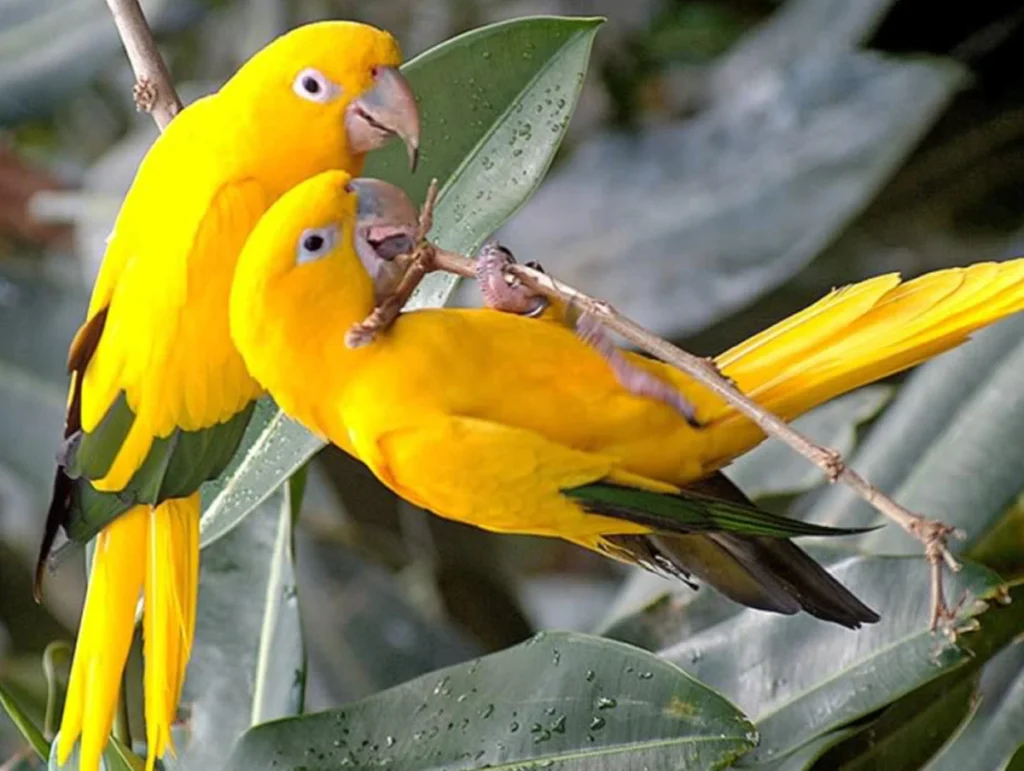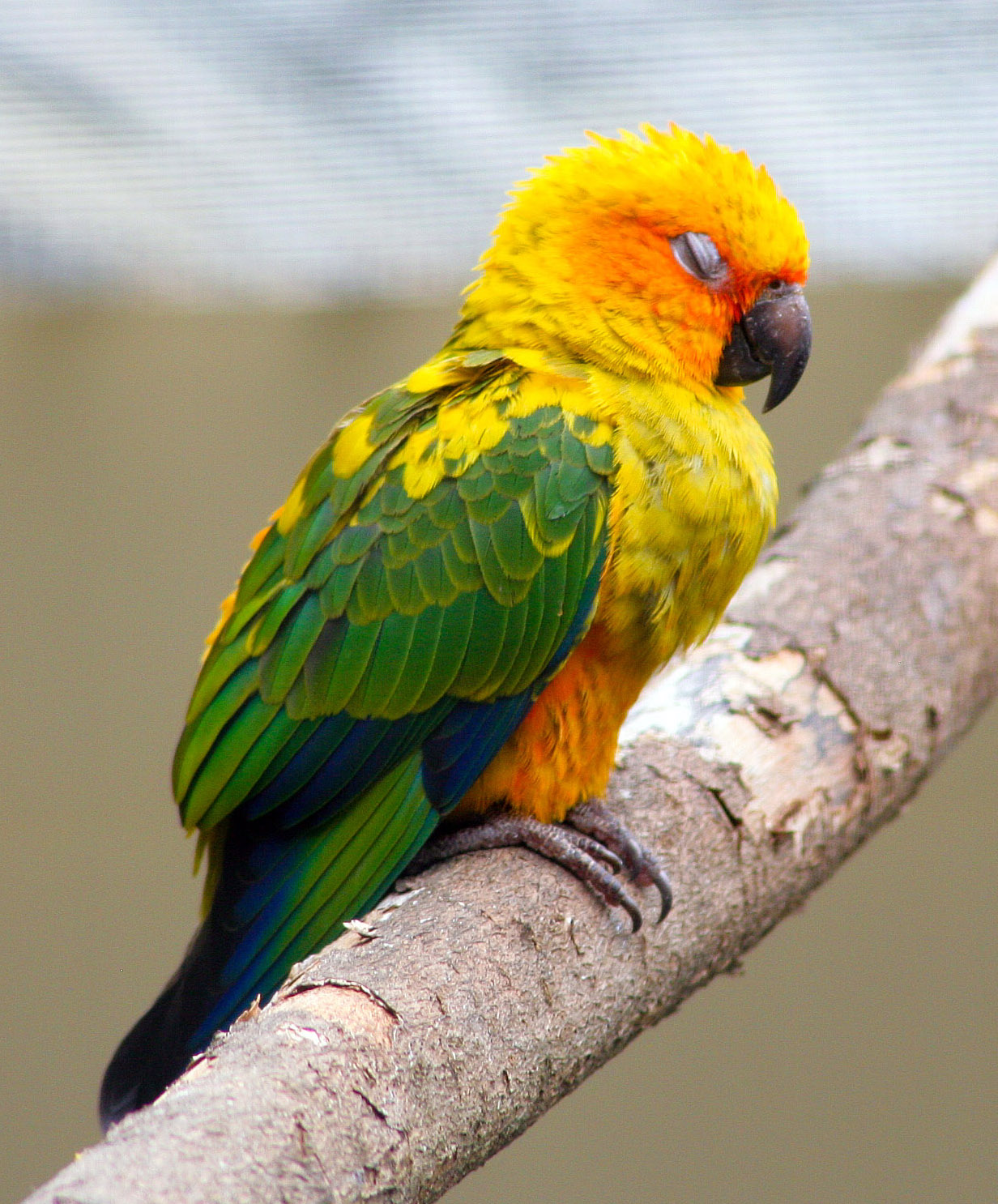Table of Contents
The Golden Conure
Introduction to Golden Conures
Golden Conures, also called Golden Parakeets or Queen of Bavaria Conures, are dazzling birds from northeastern Brazil, especially south of the Amazon River. Their bright yellow feathers and playful natures make them pop in the parrot crowd. Though they’re hard to spot in the wild because they’re shy and stick to themselves, their striking looks and quirks have gained them quite a following.
Not too long ago, researchers thought there were fewer than 3,000 of these birds. After some digging, though, it turns out their numbers sit between 6,600 and 13,400. But don’t be fooled; they’re still listed as endangered, mainly due to habitat loss and illegal trapping. Groups like World Parrot Trust are busting their tails to keep these beauties around for the long haul.

Physical Traits
Golden Conures are like sunshine on wings. They’re around 13 inches long, mostly golden-yellow with some green bits on their flight feathers. Here’s a quick look at what makes them stand out:
| Feature | Description |
|---|---|
| Length | About 13 inches |
| Main Color | Golden yellow |
| Extra Color | Green tips on wings |
| Beak | Big and gray |
| Eye Rings | Bare, pale pink |
| Eyes | Brown |
| Legs | Pink |
Young golden conures look a bit different than their fully grown buddies. Baby birds generally sport green heads and necks, which changes to the brilliant yellow as they mature.
Besides dazzling us with their looks, their colors help them recognize each other and interact. If you’re captivated by parrots and want to understand what makes each species unique, this info will set you on that path.
Want more cool bird facts? Check out our posts on macaws, African grey parrots, cockatoos, and quaker parrots. Each of these feathered friends brings its own style and charm to the table.
Get to Know the Golden Conure: Habitat and Hangouts
Understanding where the golden conure hangs out and what makes them tick is key if we want to keep these colorful birds happy, whether they’re flying free or chilling in a cage. Let’s dive into their natural digs and what they’re into.
Where Do They Live?
Golden conures set up shop in the lowland rainforests of northern Brazil, mostly around the Tocantins, lower Xingu, and Tapajós Rivers. Their home turf spans about 174,000 square kilometers. Yep, these birds are locals of the Amazon Basin.
What Kind of Place Do They Like?
- Spot: State of Pará, northern Brazil
- Height: Up to 500 meters (1640 ft)
- Scene: Lowland rainforest, some upland spots, and Brazil-nut plantations
- Seasonal Moves: Tall forests when they aren’t breeding; edge forests when they are
Social Butterfly Behavior and Chowing Down
Golden conures are pretty much the social butterflies of the bird world. They love their flocks and hang out with their bird buddies all year round.
| What They Do | How They Do It |
|---|---|
| Flock Vibes | They roll in packs of 3-30 birds |
| Sleeping | Always with the gang, all year round |
| Diet | Fresh fruits, veggies, nuts, seeds, and bird food pellets in captivity |
| Snacking Style | Nuts, fruits, flowers, and buds |
Golden conures like to mix it up, especially when they’re not breeding. They wander through different forest areas looking for a good meal. Their menu mainly includes nuts, fruits, flowers, and buds—talk about diverse eating habits!
To keep golden conures in captivity living their best lives, it’s a good idea to mimic their natural diet. Think fresh fruits, veggies, nuts, berries, grains, and top-notch bird pellets.
Knowing where golden conures come from and how they socialize helps us give them what they need. Whether they’re in the wild or your living room, making sure they’re comfy is the goal. Wanna learn more about these feathered friends? Check out our other guides and articles on parrot species with colors.
Conservation Status
Threats to Golden Conures
Golden Conures, also known as golden parakeets, are facing some serious threats out in the wild. The biggest issue? Deforestation. These birds call the Amazon Basin of Pará home, hanging out around the Tocantins, lower Xingú, and Tapajós rivers in Brazil. But as more trees get cleared, their living space just keeps shrinking.
Then there’s the illegal pet trade. These birds are like gold to traffickers because of their stunning yellow feathers. Everyone wants a flashy pet, so many conures end up being captured and sold. And traffickers? They’ll even chop down trees to get to the nestlings (Mongabay).
And if that wasn’t enough, some folks hunt these birds for food or just for fun. Because of all this, the population of Golden Conures is sitting between 10,000 and 20,000, with fewer than 10,000 left in the wild (Rio Wiki).
| Threat | Impact |
|---|---|
| Deforestation | Homeless birds |
| Illegal Pet Trade | Fewer birds in nature |
| Hunting | Getting shot for food or sport |
Conservation Efforts and Challenges
Luckily, there are some heroes out there working to save these golden beauties. Captive breeding programs have been a game-changer. Groups like the Lymington Foundation and IDEFLOR-Bio have been raising these birds in captivity and then setting them free. By 2021, they managed to add 50 golden parakeets back into the wild. These freed birds learn how to get comfy in their new surroundings and recognize predators.
Aside from adding to their numbers, these programs offer a legit way to own these birds, hopefully cutting down on the illegal trade.
But it’s not all sunshine and rainbows. Red tape and slowpoke regulators have thrown a wrench in the works. The U.S. Fish and Wildlife Service hasn’t been quick with necessary reforms, slowing down conservation fights (Pacific Legal Foundation).
Plus, for reintegration to really take off, local communities need to get on board, which means lots of education and cash. All the while, habitat loss and illegal trade still loom large.
If we get ahead of these threats, we can give Golden Conures a fighting chance. Curious about other parrot species and what’s being done to help them? Check out our articles on amazon parrot and cockatoo.
The Golden Conure’s Journey: Legal Tweaks and Real-World Impacts
U.S. Fish and Wildlife’s Big Move
Guess what? The golden conure’s finally got a status update! Just last month, the U.S. Fish and Wildlife Service decided it was time to call this bright feathered buddy threatened instead of endangered (Pacific Legal Foundation). This means the bird’s doing better and some of those old rules that breeders found annoying, like needing a permit just to move them between states, got tossed out the window.
This change didn’t happen overnight. The American Federation of Aviculture (AFA) started pushing for this back in August 2014. They were tired of dealing with what they thought were ridiculous restrictions that made it tough to keep these parrots thriving in captivity (Pacific Legal Foundation).
Here’s a quick table to show what’s changed:
| Status | Date of Change | What Changed? |
|---|---|---|
| Endangered | Before 2023 | Lots of permits, tough to transport |
| Threatened | 2023 | Fewer rules, easier transport |
Why Legal Decisions Matter
Legal changes aren’t just boring bits of paper; they have big ripple effects. Take the golden conure, for example. Delays in updating its status weren’t just frustrating for breeders and conservationists – they also hurt the bird itself. The whole point of the Endangered Species Act (ESA) is to protect species like this pretty parrot, and dragging feet on decisions wasn’t helping anybody (Pacific Legal Foundation).
Thankfully, captive breeding has stepped in as a hero. Breeding these birds in safe, legal settings stops poaching and cuts down on the illegal pet trade that once threatened them. It’s a big win for our feathered friends (Pacific Legal Foundation).
Impact of those pesky delays and tight rules:
| What Happened? | What Changed? |
|---|---|
| Reclassification took too long | Messed up breeding programs |
| Tight regulations | Made it hard to move birds around |
| Breeding in captivity worked | Less poaching, more parrots |
Captive breeding is good for birds in cages and boosts wild populations—a win-win.
Got a thing for parrots? Check out more about other feathered pals like the African grey parrot and the macaw.
Captive Care
Taking care of golden conures isn’t just a chore – it’s a joy! These vibrant birds deserve our best to stay happy and healthy. Let’s talk about how we can make their lives awesome with a bit of mental stimulation and the right food.
Keep Their Minds Buzzing
Golden conures are like little geniuses with feathers. They need activities and interactions to prevent boredom and keep their minds sharp. Bored birds can develop some pretty annoying habits like screeching or feather plucking. So, let’s keep them busy, shall we?
Fun Activities:
- Toys: Get them a mix of toys – ladders, ropes, swings, and chew toys. Keep it interesting! Check out more ideas here.
- Playtime: Spend at least three to four hours daily with them. This includes supervised time outside the cage to let them stretch those wings.
| Activity | Time (Daily) |
|---|---|
| Playtime Outside Cage | 3 – 4 Hours |
| Social Interaction | 3 – 4 Hours |
| Toy Rotation | Weekly |
Just like us, they get bored with the same old stuff. Rotate their toys weekly to keep them intrigued. Make sure playtime involves climbing and foraging – activities that come naturally to them.
For more on making your parrot’s life exciting, check out our articles on other feathered friends like the african grey and macaw.
Feed Their Bodies Right
A well-fed bird is a happy bird. Golden conures need a balanced diet to stay in top shape. That means high-quality pellets, fresh fruits and veggies, and a few seeds here and there.
Diet Breakdown:
- Pellets: Should make up about 70% of their diet.
- Fresh Produce: Apples, carrots, and leafy greens should be about 20%.
- Seeds: These should be just 10%, treat them like candy – good in moderation.
| Food Type | Part of Diet |
|---|---|
| High-Quality Pellets | 70% |
| Fresh Fruits & Veggies | 20% |
| Seeds | 10% |
Exercise is just as important as diet. These birds love to climb and explore; they need three to four hours of exercise outside their cage each day. This keeps them fit and prevents obesity.
Create a stimulating environment with ladders, ropes, and swings. Active birds are happy birds!
The Combo for Success
Combining social interaction, mental stimulation, and a balanced diet is the secret sauce. This combo ensures your golden conure lives a joyful, healthy life. For more tips on keeping your parrot in prime condition, peek at our articles on the budgie, cockatiel, and conure.
Your feathered buddy will thank you with chirps of delight!
Species Management
Preserving the golden conure, also known as the Queen of Bavaria conure, is a challenge worth taking on. Let’s dig into the current population numbers and the breeding and reintroduction efforts that aim to keep this dazzling parrot around for generations.
Population Estimates
Golden conures are exclusive to a slice of land south of the Amazon River in northeastern Brazil. They’re real head-turners with their bright feathers, but spotting one in the wild is like finding a needle in a haystack, thanks to their shy nature. Early guesses pinned their numbers at under 3,000. Fresh eyes and better methods, though, bump that figure up to somewhere between 6,600 and 13,400 The Spruce Pets.
Here’s a quick look at the estimates:
| Estimate Year | Minimum Population | Maximum Population |
|---|---|---|
| Initial Estimate | less than 3,000 | — |
| Latest Estimate | 6,600 | 13,400 |
Despite the more optimistic stats, golden conures are still hanging by a thread due to ongoing habitat wreckage and illegal poaching.
Breeding Programs and Reintroduction Efforts
The golden conure’s vulnerable status makes breeding programs not just helpful but crucial. Many breeders have shifted gears from selling conures as pets to beefing up their numbers through careful breeding (The Spruce Pets). These initiatives don’t just aim to up the bird count; they get conures ready for life back in the wild.
The Lymington Foundation and IDEFLOR-Bio have been running these breeding programs for the past couple of decades. By 2021, they had released 50 conures back into their native environment. These birds went through a ‘training camp’ to get used to the local food and learn to dodge predators.
A 2021 report showed that these reintroduced parakeets were cracking it in the wild: finding food, avoiding danger, and—big win—one pair even had chicks. Proof positive that these programs are working, bringing the conures back to places like Belém where they hadn’t been seen for ages (Mongabay).
For bird watchers, conservationists, and anyone who cares about our feathered friends, these programs are more than just numbers. They’re the key to seeing golden conures thrive once more. By diving into these stories, we get a better picture of our role in defending these wonderful birds and can pitch in to keep up the good work.
Keen on learning more about parrots? Don’t miss our takes on the macaw, african grey parrot, and other parrot species.
Field Research and Conservation
Research Efforts and Observations
We’ve been diving deep into the world of golden conures, aiming to uncover their secrets and help keep them safe. Since 1999, the World Parrot Trust has rolled up its sleeves and hit the field to monitor and protect these amazing birds. In 2007, their team ventured into the Western state of Para, Brazil, and hit the jackpot with some cool discoveries about what these birds munch on, how they hang out, and where they sleep and nest (World Parrot Trust).
Some fascinating tidbits:
- New foods the golden conure loves.
- Their unique way of socializing.
- Brand new spots where they rest and nest.
Here’s a quick snapshot of what the field research turned up:
| Year | Region | Cool Findings |
|---|---|---|
| 2007 | Para, Brazil | Fresh food choices, flock vibes, new roosting/nesting trees |
But it’s not all sunshine and rainbows. The research also threw light on some serious threats, like deforestation and nestling trapping, especially around the Amazonia National Park.
Collaborators in Conservation
Saving the golden conure isn’t a solo mission. It takes a village, and we’ve had some amazing help along the way. Here’s a shoutout to our key partners and supporters:
- INPA (Instituto de Pesquisa da Amazonia)
- BioBrasil
- Tennessee Valley Exotic Bird Club
- Grant Hacking
- Glenn Reynolds
- Lymington Foundation
These troopers have been crucial in backing our efforts to keep the golden conure thriving. With their continued support, we keep moving forward, making sure these incredible birds have a fighting chance.
Interested in learning about more parrot pals? Check out our articles on african grey parrots, cockatoos, and macaws.
Success Stories
Celebrating the triumphs in conservation, especially when it comes to the majestic golden conure, brings a sense of excitement. Let’s check out some of the biggest wins and envision the bright future for this captivating bird.
Comeback Kids: Reintroduction Programs
In the past 20 years, a bunch of dedicated folks have been hard at work saving the golden conure. Take a bow, Lymington Foundation and IDEFLOR-Bio. They’ve not only bred these stunning parakeets but even let 50 of them soar back into the wild by 2021.
| Year | Golden Conures Reintroduced |
|---|---|
| 2017 | 10 |
| 2018 | 12 |
| 2019 | 14 |
| 2020 | 6 |
| 2021 | 8 |
No small feat, right? The conservationists not only got the birds ready for reintroduction but trained them for survival—teaching them the ropes about spotting predators and finding food.
Eyes on the Prize: Future Goals
Looking ahead, we’re all set for bigger and better targets. We aim to reintroduce even more golden conures and expand our breeding programs. Our goal? Get at least 100 golden conures back where they belong in five years.
| Year | Projected Conures Reintroduced |
|---|---|
| 2022 | 10 |
| 2023 | 15 |
| 2024 | 20 |
| 2025 | 25 |
| 2026 | 30 |
To hit these numbers, teamwork is a must. We need to join forces with other organizations and local communities. Working together, we’ve already seen great results, and it sets the stage for future success. Including locals in the effort also ensures lasting impact on the golden conure population.
As these reintroduction efforts gather steam, we’re hopeful that golden conures will not just survive but thrive in the wild. By fostering a bond with these special birds, we help secure their future among the wondrous parrot species of our planet.
For more stories about these incredible creatures, check out our pages on the macaw, amazon parrot, and cockatoo. Let’s keep rooting for these magnificent beings on their path to a sustainable future.

